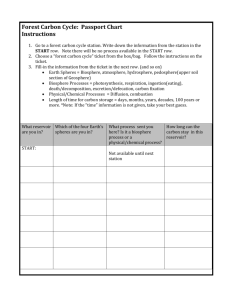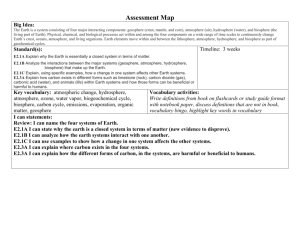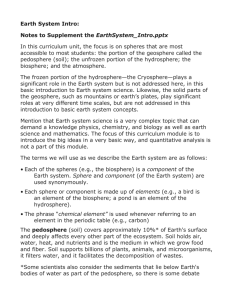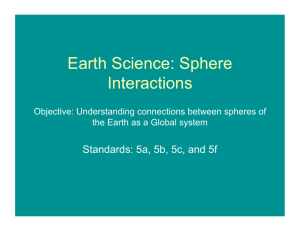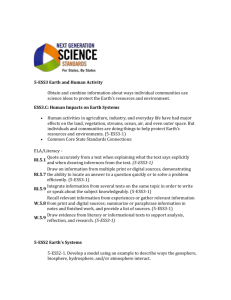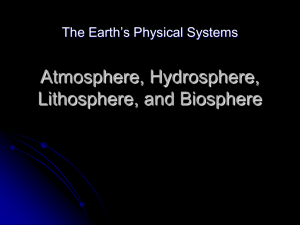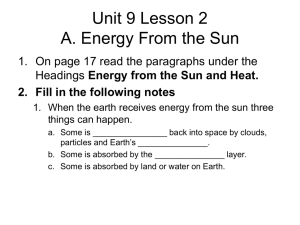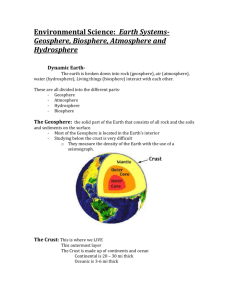Earth System: The Basics
advertisement
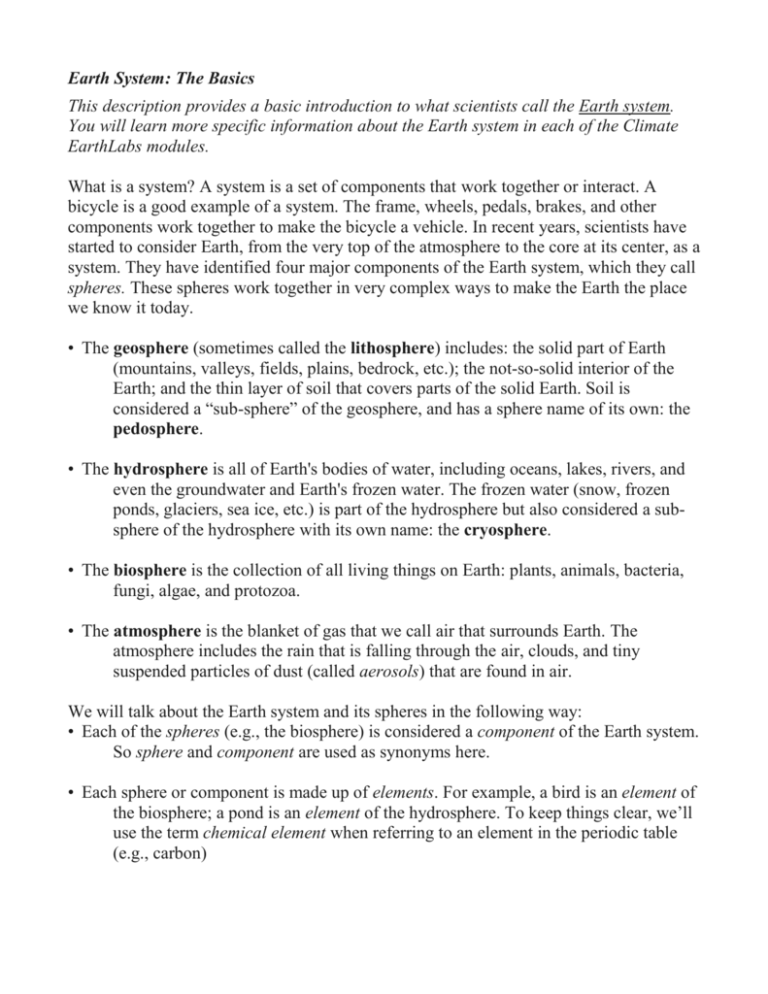
Earth System: The Basics This description provides a basic introduction to what scientists call the Earth system. You will learn more specific information about the Earth system in each of the Climate EarthLabs modules. What is a system? A system is a set of components that work together or interact. A bicycle is a good example of a system. The frame, wheels, pedals, brakes, and other components work together to make the bicycle a vehicle. In recent years, scientists have started to consider Earth, from the very top of the atmosphere to the core at its center, as a system. They have identified four major components of the Earth system, which they call spheres. These spheres work together in very complex ways to make the Earth the place we know it today. • The geosphere (sometimes called the lithosphere) includes: the solid part of Earth (mountains, valleys, fields, plains, bedrock, etc.); the not-so-solid interior of the Earth; and the thin layer of soil that covers parts of the solid Earth. Soil is considered a “sub-sphere” of the geosphere, and has a sphere name of its own: the pedosphere. • The hydrosphere is all of Earth's bodies of water, including oceans, lakes, rivers, and even the groundwater and Earth's frozen water. The frozen water (snow, frozen ponds, glaciers, sea ice, etc.) is part of the hydrosphere but also considered a subsphere of the hydrosphere with its own name: the cryosphere. • The biosphere is the collection of all living things on Earth: plants, animals, bacteria, fungi, algae, and protozoa. • The atmosphere is the blanket of gas that we call air that surrounds Earth. The atmosphere includes the rain that is falling through the air, clouds, and tiny suspended particles of dust (called aerosols) that are found in air. We will talk about the Earth system and its spheres in the following way: • Each of the spheres (e.g., the biosphere) is considered a component of the Earth system. So sphere and component are used as synonyms here. • Each sphere or component is made up of elements. For example, a bird is an element of the biosphere; a pond is an element of the hydrosphere. To keep things clear, we’ll use the term chemical element when referring to an element in the periodic table (e.g., carbon) Reservoirs Each of the spheres holds matter. For example, although it is obvious that the hydrosphere holds water, there is also water in the biosphere, water in the atmosphere, and water in the pedosphere. Each of the spheres also holds oxygen, various forms of carbon, and other chemical elements or materials. All of the matter on Earth can be placed in one or more spheres. The term reservoir is used to describe the total amount of specific matter in a sphere. For example, there is a reservoir of carbon in the atmosphere, a reservoir of carbon in the geosphere, a reservoir of oxygen in the biosphere, and so on. The size of a reservoir is often described in term of tons or gigatons (billions of tons). Likewise, each sphere holds energy (mostly heat energy or chemical energy). For example, there is a vast amount of heat energy in the atmosphere or in the hydrosphere. The greatest source of this heat energy is the Sun. Interconnections and Processes Matter and energy are always circulating among the spheres, connecting them in many ways. Sometimes this circulation can happen very quickly, such as when a volcano erupts, moving tons of tiny particles from the geosphere into the atmosphere. Other examples of circulation happen much more slowly, such as when a fallen tree decays and nutrients move from the biosphere to the pedosphere. Transfer of matter Whenever matter moves from one sphere into another, some process, driven by energy, causes it to happen. Here are some examples: • Water moves from a river (hydrosphere) into the air (atmosphere) by a process called evaporation. • Carbon dioxide moves from your body (biosphere) into the air (atmosphere) by a process called respiration. • Minerals move from rock (geosphere) into the soil (pedosphere) by the process of weathering. Processes move matter not only from one sphere to another, but also from one element of a sphere to another element of a sphere. For example: • Nutrients move from a plant (biosphere) into a bird’s body (biosphere) by the processes of consumption and digestion. In Balance with Available Energy Because these processes are driven by energy, they need to be in balance with the available energy. For example, decay slows down as temperatures drop and the activity of decomposers also slows. Evaporation increases when temperature or wind speed increase. Photosynthesis increases as days lengthen and available sunlight increases. The transfer of energy In addition to the movement of matter, energy also moves from one sphere to another For example: • The sun warms the pedosphere, which transfers its heat to the atmosphere by radiation. • Warm air transfers heat to cooler land surfaces by conduction. • Rivers and ocean currents move heat energy from one place to another by convection. • Rain can warm or cool the pedosphere on which it falls via conduction. Change Leads to Change Because of the interconnectedness of the spheres, changes in one sphere bring about changes in the others. For example: • Droughts (atmosphere) can cause severe changes in the hydrosphere, the biosphere, and the pedosphere. • The increased water level in a lake has an impact on the plants and animals that inhabit the shoreline. • The extraction and burning of fossil fuels (oil, gas, coal) reduces the amount of carbon stored in the geosphere and increases the amount of carbon in the atmosphere, in the form of carbon dioxide. Moving Forward As you study one or more of the EarthLabs Climate modules, or even as you think about what is happening in the natural world around you, keep in mind the concept of the Earth system, with its spheres, reservoirs of matter and energy, and processes that drive matter and energy from one sphere to another. These concepts can help you better understand the very dynamic nature of our planet, even when processes happen at rates that are much more gradual than the eruption of a volcano or flooding that results from a wild storm.

